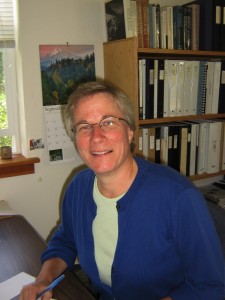
Lisa Byers, in her office at OPALOPAL turns towards stewardship: housemoving, resales, and finance education
Gala dinner October 1; National Conference Tours Oct. 24
This Saturday’s Gala Dinner for Of People and Land (OPAL) Community Land Trust is a milestone in many ways for the Orcas Island Community and for OPAL’s Director, Lisa Byers.
The dinner will honor OPAL’s Charter and Lifetime Members: Marilyn Anderson, Peter Fisher, Michael and Penny Sky.
“We wanted to recognize people who have been longtime, durable supporters,” said Byers, “people who’ve come together around this mission. We’ll be telling their stories, their interest in OPAL, why they believed in OPAL at first, and why they continued to sustain the organization.
“Their stories are inspiring and breed more success.”
It will also provide a retrospective of the 22 years of OPAL’s existence, through a large-scale photography exhibit, mounted by Chris and Vicki Brems in collaboration with Peter Fisher. Two walls of the Madrona Room will display a retrospective of OPAL over the last 22 years, providing Land Trust homes at Opal Commons, Bonnie Brae, Oberon Wood, Reddick Farmhouse and Apartments, Lahari Ridge, Madrona Street, Wild Rose Meadow and at scattered sites.
Byers also promises entertainment in the form of “skits that people will find entertaining and humorous; Janet Brownell and Helen Bee will share top billing in a group effort.”
Tickets for the Oct. 1 dinner at the Madrona Room are $125 ($90 tax deductible) and are available by calling OPAL at 376-3191.
Moving forward after the Gala, Byers will be taking part in the National Community Land Trust (CLT) Network’s annual Conference in Seattle, from Oct. 24-27. The National CLT Network Conference is a time when new board members are elected and leadership changes. This coming year, Byers will continue to serve on the board of directors of the CLT Network, and it will be announced that in 2012 she will take over as Dean of CLT Academy, the teaching arm of the network.
Byers is one of the founders of the CLT Network in 2005 which grew out of the Institute for Community Economics to provide support and leadership for CLTs around the country. She served as its President in 2007-08.
The national conference next month will begin with an all-day trip to the San Juans, for conference attendees to tour the CLTs on Orcas and Lopez Islands.
Byers came to Orcas Island nearly 20 years ago after a meeting with Penny Sharp Sky back east. She initially worked for the Land Bank and declined the position of OPAL’s Executive Director when it was first offered to her. She says, “You can’t fundraise without knowing the community.”
However, she did serve on the OPAL board beginning in 1994, recognizing its “great mission and great people.”
In 1996, Byers became Executive Director – and the sole employee — of OPAL CLT. At the time, the Land Trust held 18 homes. That number is now 120.
Byers says OPAL’s success in its mission — to provide permanent affordable housing for the benefit of the Orcas Island Community — is due to “The people who lead OPAL are passionate about the island and social justice. They have a personal interest in keeping the community as engaging and diverse as possible.”
She attributes the key ingredient that makes their work successful to the consensus, decision-making process.
“We get to know board candidates well before appointing them, because consensus is not for everyone,” says Byers. She adds, “OPAL is in a position where the consensus model can work because we have a mission that’s fairly narrow.
“We try to craft solutions that satisfy all at the table; setting policy that incorporates the thinking of all. We don’t move forward until everyone’s thinking has been considered. A lot is based on each person speaking as fully and truthfully as they can, so that nuance is explored.
“The other key is if someone is blocking consensus, is to see if the obstacle is personal preference, rather than what’s best for the organization – there’s some soul-searching involved in that. Ninety-eight percent of the time, people will shift their opinion and come to agreement.
“We have walked away from some projects out of respect for the consensus process. The discussion may be tabled for pondering and consideration.”
Byers clarifies the process: “Consensus does not mean compromise, where a person ‘gives in’ so that another person will agree to ‘give in’ on a different element, but it means a solution crafted from the best thinking of those who are present.
”People need to be as informed as possible for consensus to be an appropriate tool.
“We know when we’re there,” Byers says.
The consensus process carries over to the monthly OPAL neighborhood meetings. Byers says, “We sometimes struggle, but each neighborhood has developed its own culture. Sometimes they ask OPAL staff to attend meetings or help them interpret or frame the issues to be resolved.”
The process has served OPAL well: this year the organization moved three houses, acquired Lavender Hollow Apartments, and completed the Wild Rose Meadow $10.1 million, 32-home project.
With the completion of Wild Rose Meadow and purchase of Lavender Hollow, OPAL has about doubled its number of homes in two years.
OPAL is now focused on “developing our role as stewards, continuing to provide technical support for neighborhoods,” such as the extended sewer line in the Bonnie Brae neighborhood, and working with Lahari, the non-profit dedicated to providing services for the elderly, regarding the sale of its house in OPAL’s Lahari Ridge neighborhood in Deer Harbor.
Byers says with a smile “CLT – the developer that doesn’t go away.”
Stewardship includes the resale process: “part of OPAL’s evolution, and the maturing of the organization’s neighborhoods,” says Byers.
Currently OPAL is facilitating the re-sale of eight existing OPAL homes. The transfer process involves maintaining OPAL homes in good condition, so that they keep their funding grants from agencies such as the Washington State Housing Trust fund, federal Community Development Block Grants, and Housing and Urban Development (HUD) Self-Help Opportunity Program, as well as from private foundations.
Resale values for OPAL homes are tied to their value in the Consumer Price Index and to financial incentives for improvements and/or maintenance. “It happens that the homes may appreciate in value from its original purchase date,” says Byers.
“The typical seller probably makes 3.1 percent [market value gain] per year on what they’ve put into the house.
“We’re definitely a hybrid, in that [traditional] rentals don’t gain a financial benefit, and the CLT model (without land ownership) does provide that.”
Byers says the OPAL budget varies from year to year:, “Because our work is so capital-intensive, it’s hard to say. If there’s not a new delivery of home, the budget is probably around $350,000. Most years, our budget is between one and three million dollars.
“We have scaled down in recent years. In many ways that’s what so elegant about moving houses.
“But using a house moving company is dependent on the capacity of local contractors who know how to work with the house movers to accomplish all aspects of the move,” Byers says.
“It costs about $50,000 to move a house, and we strive to break even in site infrastructure. The [moved]houses sell for about $165,000.”
As she finds her job as Executive Director shifting more to “writing grants, securing loans, compiling statistics, attending meetings or forecasting our cash flow,” Byers finds multi-tasking a challenge: “I don’t like it when there’s too many things demanding my time in different directions at the same time.”
She also is determined “to avoid getting too sucked into the fear dynamic of our culture: I credit the board with helping in that a lot.”
She cites the OPAL Boards “experience of the ebbs and flows of economy. They’re very good at taking calculated risks. It’s good to be part of a group of people analyzing the upsides and downsides of issues.
“They take the long-term perspective, and that boosts my confidence.”
If grant funds become available, OPAL plans a modest foreclosure prevention program to enable people to convert to OPAL ownership. The OPAL mission “doesn’t always have to be about building,” says Byers.
“The number of poor is growing and the definition of affordable permanent housing is expanding.
The core principles of the National Community Land Trust Network to guide the work of its members are:
- Perpetual Affordability
- Community Health, Cohesion, and Diversity
- Community Stewardship of Land
- Perpetual Sustainability
- Representative Governance
- Resident and Community Empowerment
Those involved in OPAL and other CLTs blend together the “pragmatic and philosophical strains” of the taxing and ownership bases of Land Trusts. Byers says, “For some of us they blend together beautifully; for some it’s two different spheres.
“Mostly we are drawn to it for the philosophy and believe that shelter is not to be treated as a commodity.”
“One of the things this year has taught me is our commitment as an organization to be responsive and creative. We remain committed to additional permanently affordable housing.
“I am stunned and exhilarated by the many ways in which we can do it. “
**If you are reading theOrcasonian for free, thank your fellow islanders. If you would like to support theOrcasonian CLICK HERE to set your modestly-priced, voluntary subscription. Otherwise, no worries; we’re happy to share with you.**





